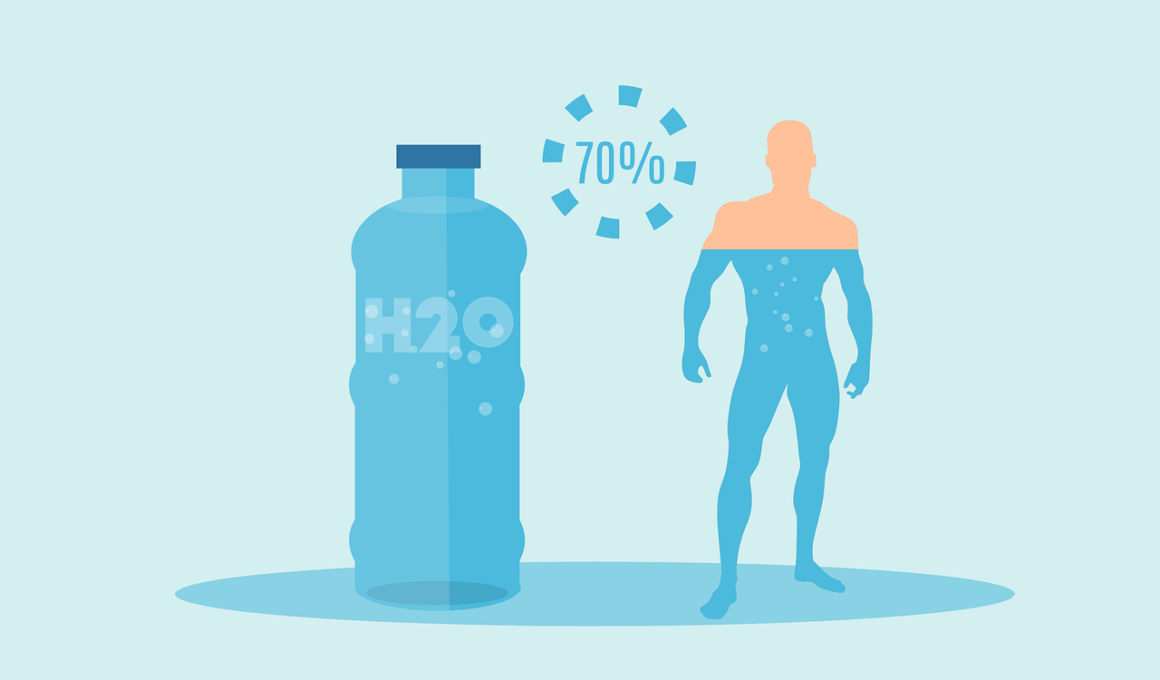Water Bottles and Hydration Solutions for Long-Distance Runners
Every long-distance runner must prioritize hydration during training and races. Proper hydration not only affects performance but also impacts overall health. Therefore, selecting the right water bottle and hydration solution is crucial for runners. Many runners, especially those training for marathons, encounter issues with convenience and accessibility when attempting to hydrate. Depending on the distance, maintaining hydration regularly is vital; thus, runners need to familiarize themselves with various options available in the market. There are numerous types of water bottles, each designed to meet particular needs. For example, handheld bottles are popular among many as they allow for quick access without needing to stop. Alternatively, hydration packs comfortably distribute weight while providing increased water storage capacity during long runs. Ensuring that the water bottle is lightweight, easy to carry, and leak-proof can significantly affect a runner’s experience. Additionally, features such as built-in straws and wide mouths can further enhance convenience for hydration during races. Investing in quality hydration solutions can enhance both training and race-day performance significantly. Therefore, evaluating different options suited to individual preferences will help runners make informed choices.
Aside from traditional water bottles, many runners are exploring advanced hydration solutions. These include hydration belts that distribute bottles around the waist, allowing runners easy access without disrupting their pace. Such belts are particularly useful for longer distances, as they help maintain balance while ensuring hydration is just an arm’s reach away. Additionally, some hydration systems come with insulated bottles, maintaining your drink at the preferred temperature. This is essential during hot weather or if consuming sports drinks or flavored electrolytes that can drastically improve endurance. Recognizing the importance of electrolyte replenishment is also essential. Many hydration packs and belts now feature compartments for electrolytes or energy gels, providing an all-in-one solution for hydration and energy. Portable filtration systems are another innovative approach. These allow runners to carry water safely from natural sources, ensuring a steady supply of hydration on lengthy trails. Furthermore, many modern bottles are made from sustainable materials, promoting eco-friendly choices among conscientious runners. This is crucial for maintaining the health of our planet while pursuing personal fitness goals. Making informed decisions on hydration solutions supports not just improved physical performance but also environmental responsibility.
Choosing the Right Hydration Solution
When selecting a hydration solution, personal preferences and individual running styles play a significant role. It is essential for runners to consider factors such as running speed, distance, and the environments they’ll be facing. Some prefer minimalist setups, using handheld bottles for quick sips, while others might opt for bulky, multi-bottle hydration packs they can fill for longer outings. Assessing body frame and comfort with various carrying options is vital in making choices that can either hinder or enhance running efficiency. Also, convenience is crucial. Runners should evaluate how quickly they can drink and refill without causing significant delays in their pacing. Bottles with easy-open caps or straws can expedite the drinking process. When testing different options, it can be beneficial to go on a few trial runs. This way, runners can determine what feels comfortable and what doesn’t during their usual training regimes. Additionally, the weather and terrain can influence choice, as runners may require different setups for hot summer runs versus cooler, wetter conditions. Finding a hydration solution that complements individual needs is key to uninterrupted runs and maintaining optimal performance.
Another essential aspect of hydration solutions involves addressing personal hydration needs during races or long runs. Runners must establish how much and how often they should drink. Research suggests that consuming about half a liter of water per hour is typically adequate, but fluctuations can occur based on weather conditions or workout intensity. The best method to determine personal hydration needs involves experimenting during regular training. Many runners utilize hydration strategies that include learning how to sip small amounts at regular intervals instead of chugging large quantities at once. This consistency helps prevent cramping and sluggishness. Additionally, flavors can play a significant role. Some runners prefer flavored electrolyte solutions, as these can encourage more fluid intake, especially when tackling long distances. The option of alternating between water and electrolyte drinks can help mitigate the risk of dehydration and improve performance over time. Therefore, keeping track of consumption, endurance levels, and thirst during training can enhance the efficiency of hydration techniques. Committing these strategies to practice can markedly improve comfort and endurance on race day.
The Importance of Maintaining Hydration
Understanding the signs of dehydration is crucial for serious long-distance runners. Symptoms like fatigue, muscle cramps, dizziness, and decreased performance can indicate inadequate hydration levels. Recognizing these indicators allows runners to respond quickly and make adjustments on top of safe hydration practices. It’s equally essential to note how color can reflect hydration status. A lighter urine color usually indicates proper hydration, while darker shades suggest the need for more fluids. Ultra-endurance runners often experience unique hydration challenges due to prolonged exertion. They may require more than just water due to sweat loss. Supplementing fluid intake with electrolyte solutions can replenish lost important minerals and stave off fatigue. Many runners are now seeking professional help to establish personalized hydration plans according to their unique sweat rates and fitness levels. These plans help optimize training and performance. Hydration doesn’t just affect running; it also impacts overall recovery. Staying hydrated post-run helps repair muscle tissues and prolongs endurance in future workouts as well. Thus, by giving hydration the attention it deserves, runners can foster overall health and improve their performance in the long run.
As runners continue to emphasize the importance of proper hydration, innovative trends and technologies are emerging in hydration gear. Smart water bottles are hitting the market, introducing features such as hydration reminders, tracking consumption levels, and even providing real-time data on hydration status. Wearable technology has also evolved, allowing runners to sync hydration systems to watches or fitness trackers, improving awareness of hydration needs tailored to workouts. Additionally, biodegradable and reusable materials are being integrated into the production of hydration solutions, reducing the waste generated by single-use products. This shift indicates a growing awareness of sustainability within the running community. Such innovations benefit personal hydration strategies while maintaining a commitment to environmental responsibility. Moreover, community events, local races, and clubs are beginning to emphasize the importance of hydration education, ensuring runners are well-informed before they hit the trails or pavement. This collective effort to raise awareness about efficient hydration methods is creating a ripple effect, encouraging participation and better performance standards among athletes. Ultimately, embracing these innovations can further enhance the positive impacts of hydration solutions on every runner’s journey.
Conclusion and Preparation for Races
Preparing for a marathon means addressing every facet of running, and hydration remains a cornerstone. As race day approaches, developing a structured hydration plan becomes vital. Endurance runners should practice hydration strategies during training runs to establish habits that will serve during races. Understanding race conditions, like a summer marathon versus a winter event, will also influence the needed hydration approach. Many runners will carry water, while others may opt to refill at stations along the course, which calls for pre-race preparation to know the locations of these stations. Being aware of hydration needs connects runners to their bodies, enabling them to listen to cues and respond accordingly. Additionally, trying various electrolyte products during training ensures comfort level on race day. Having a backup plan for hydration can ease nerves and ensure proper maintenance throughout the race. With the commitment to staying hydrated as part of the overall strategy, runners can focus on pacing, performance, and finishing strong. By marrying training, knowledge, and preparedness with efficient hydration, long-distance runners position themselves for success and satisfaction in their marathon journeys.
In conclusion, the importance of hydration cannot be overstated, especially for long-distance runners. Focusing on proper water bottles and hydration gear can significantly impact training and race performance. The right solutions empower runners to stay hydrated, maintain optimal energy levels, and prevent fatigue during their runs. Trials and personal preferences are essential when discovering the ideal hydration options, ensuring runners develop a toolbox suitable to their unique needs. From handheld bottles to hydration packs, every option offers unique benefits. Incorporating these factors into ongoing training will likely cultivate more efficient habits and reliable results. Runners who take their hydration seriously will reap the rewards of improved endurance and comfort during races. Furthermore, fostering an understanding of hydration practices emphasizes personal accountability and elevates the sport as a whole. By taking responsible action concerning hydration, runners can actively contribute to their health and well-being while enjoying their marathon experiences. Ultimately, the key to success lies in informed choices, continuous learning, and the integration of efficient hydration practices into daily training routines. Every drop counts on the journey to completing marathons and achieving personal fitness goals.


